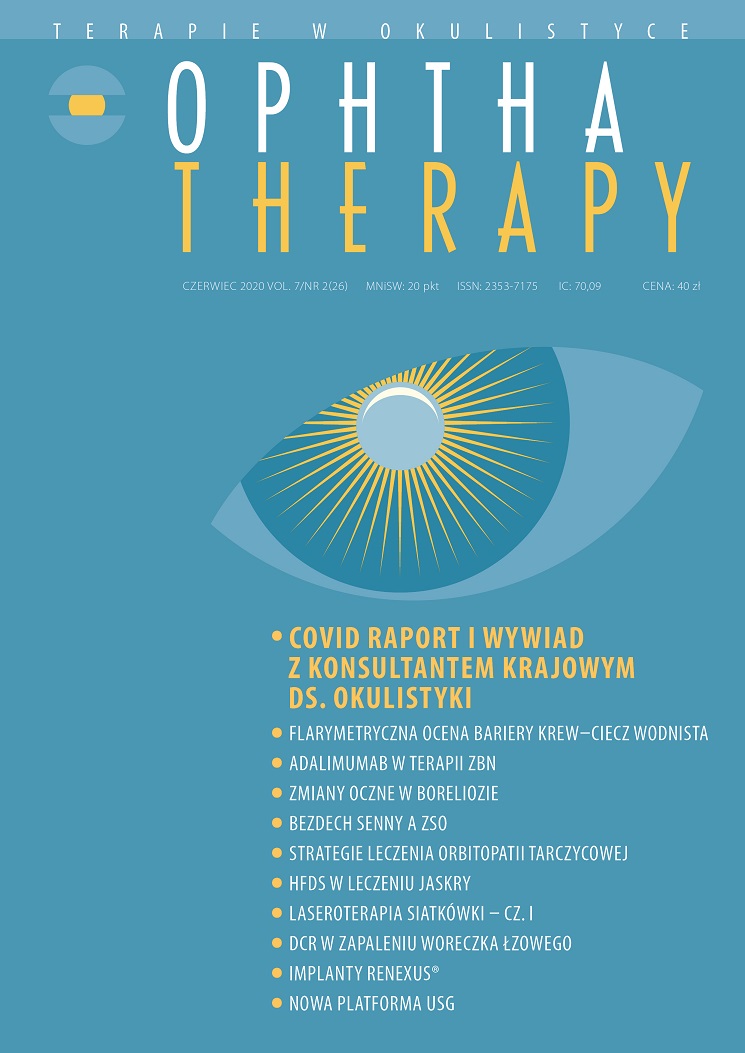Choroby odzwierzęce w okulistyce. Część III – zmiany w przebiegu boreliozy Artykuł przeglądowy
##plugins.themes.bootstrap3.article.main##
Abstrakt
Borelioza, choroba odkryta w latach 70. XX w., o nie do końca jeszcze wyjaśnionych mechanizmach patofizjologicznych i obrazie klinicznym, wzbudza powszechne zainteresowanie. Liczba rozpoznawanych przypadków boreliozy w Polsce w ciągu ostatniego dziesięciolecia rośnie. Nasz kraj jest endemiczny dla boreliozy, mamy jeden z najwyższych odsetków osób zarażonych w Europie. Borelioza to odzwierzęca choroba wektorowa przenoszona przez kleszcze, powodowana przez krętki Borrelia burgdorferi. Jedną z najmniej znanych, udokumentowanych i rzadko rozpoznawanych postaci jest borelioza oczna. Zmiany mogą powstać zarówno w przednim, jak i w tylnym odcinku oka, zależnie od fazy choroby. We wczesnej fazie, gdy ukąszenie przez kleszcza nastąpiło blisko gałki ocznej, rumień zawierający krętki może „przez ciągłość” objąć powieki lub spojówki oka. W drugiej fazie, gdy krętki rozprzestrzenią się po całym organizmie i z powodu predylekcji do tkanki nerwowej zajmują nerwy czaszkowe, może to dotyczyć także nerwu wzrokowego, rzadziej nerwów okoruchowych oraz siatkówki. Zatem borelioza oka w drugiej fazie jest rodzajem neuroboreliozy. W tej fazie zwykle przebiega z zapaleniem opon i/lub mózgu.
Obok wywiadu i obrazu zmian podstawowe znaczenie w rozpoznaniu ocznej boreliozy mają dostępne komercyjnie w Polsce badania serologiczne.
W artykule opisano ważny dla zrozumienia tej jednostki chorobowej fazowy przebieg boreliozy. Wyjaśniono przyczyny różnic w przebiegu klinicznym występujące w starym i nowym świecie, opisane z punktu widzenia epidemiologii. Omówiono obraz kliniczny, leczenie i rokowanie w boreliozie ocznej.
Pobrania
##plugins.themes.bootstrap3.article.details##

Utwór dostępny jest na licencji Creative Commons Uznanie autorstwa – Użycie niekomercyjne – Bez utworów zależnych 4.0 Międzynarodowe.
Copyright: © Medical Education sp. z o.o. License allowing third parties to copy and redistribute the material in any medium or format and to remix, transform, and build upon the material, provided the original work is properly cited and states its license.
Address reprint requests to: Medical Education, Marcin Kuźma (marcin.kuzma@mededu.pl)
Bibliografia
2. Burgdorfer W. Discovery of the Lyme disease spirochete and its relation to tick vectors. Yale J Biol Med. 57; 518-20: 1984.
3. Weber K. Aspects of Lyme Borreliosis in Europe. Eur J Clin Microbiol Infect Dis. 2001; 20(1): 0006-0013. https://doi.org/10.1007/s100960000412.
4. Strnad M, HönigV, Růžek D et al. Europe-Wide Meta-Analysis of Borrelia burgdorferi Sensu Lato Prevalence in Questing Ixodes ricinus Ticks. Appl Environ Microbiol. 2017; 83(15): e00609-17. https://doi.org/10.1128/AEM.00609-17.
5. Kahl O, Janetzki-Mittmann C, Gray JS et al. Risk of infection with Borrelia burgdorferi sensu lato for a host in relation to the duration of nymphal Ixodes ricinus feeding and the method of tick removal. Zentralbl Bakteriol. 1998; 287: 41-52.
6. de Silva AM, Fikrig E. Growth and migration of Borrelia burgdorferi in Ixodes ticks during blood feeding. Am J Trop Med Hyg. 1995; 53: 397-404.
7. Rauer S, Kastenbauer S, Hofmann H et al. Guidelines for diagnosis and treatment in neurology – Lyme neuroborreliosis. Ger Med Sci. 2020; 18: Doc03. Published 2020 Feb 27. https://doi.org/10.3205/000279.
8. Wójcik-Fatla A, Zając V, Sawczyn A et al. Infections and mixed infections with the selected species of Borrelia burgdorferi sensu lato complex in Ixodes ricinus ticks collected in eastern Poland: a significant increase in the course of 5 years. Exp Appl Acarol. 2016; 68: 197-212. https://doi.org/10.1007/s10493-015-9990-4.
9. Czarkowski MP, Cielebąk E, Kondej B et al. Infectious diseases and poisonings in Poland in 2018. Warsaw 2019, NIZP-PZH, GIS.
10. Zbrzeźniak J, Paradowska-Stankiewicz I. Lyme disease in Poland in 2017. Przegl Epidemiol. 2019; 73(3): 317‐20. https://doi.org/10.32394/pe.73.37.
11. Paradowska-Stankiewicz I, Chrześcijańska I. Lyme disease in Poland in 2015. Przegl Epidemiol. 2017; 71(4): 513‐7.
12. Brydak-Godowska J, Moskal K, Borkowski PK et al. A Retrospective Observational Study of Uveitis in a Single Center in Poland with a Review of Findings in Europe. Med Sci Monit. 2018; 24: 8734-49. https://doi.org/10.12659/MSM.910749.
13. Tran VT, Auer C, Guex-Crosier Y et al. Epidemiological characteristics of uveitis in Switzerland. Int Ophthalmol. 1994–1995; 18: 293-98.
14. Bodaghi B, Cassoux N, Wechsler B et al. Chronic severe uveitis: Aetiology and visual outcome in 927 patients from a single center. Medicine. 2001; 80: 263-70.
15. Grajewski RS, Caramoy A, Frank KF et al. Spectrum of uveitis in a Germany Tertiary Center: Review of 474 consecutive patients. Ocul Immunol Inflamm. 2015; 23: 346-52.
16. Błaut-Jurkowska J, Jurkowski M. Zespół poboreliozowy [Post-Lyme disease syndrome]. Pol Merkur Lekarski. 2016; 40(236): 129‐33.
17. Rebman AW, Aucott JN. Post-treatment Lyme Disease as a Model for Persistent Symptoms in Lyme Disease. Front Med (Lausanne). 2020; 7: 57. https://doi.org/10.3389/fmed.2020.00057.
18. Zalecenia PTEiLChZ. http://www.pteilchz.org.pl/informacje/rekomendacje.
19. Moniuszko A, Dunaj J, Zajkowska J et al. Comparison of detection of Borrelia burgdorferi DNA and anti-Borrelia burgdorferi antibodies in patients with erythema migrans in north-eastern Poland. Postepy Dermatol Alergol. 2015; 32(1): 11‐14. https://doi.org/10.5114/pdia.2014.40940.
20. Lebech AM, Hansen K, Brandrup F et al. Diagnostic Value of PCR for Detection of Borrelia burgdoferi DNA in Clinical Specimens From Patients With Erythrema Migrans and Lyme Neuroborreliosis. Mol Diag. 2000; 2: 139-50.

